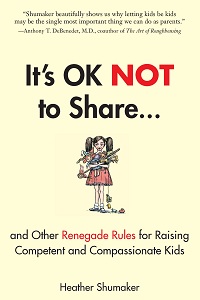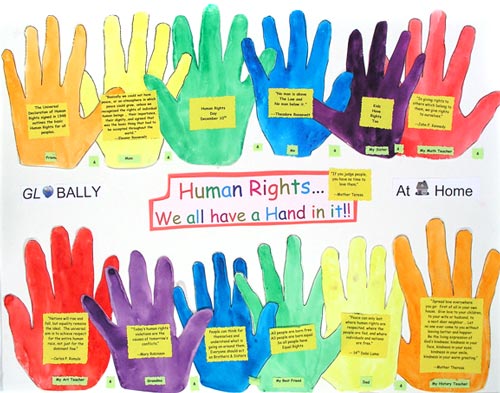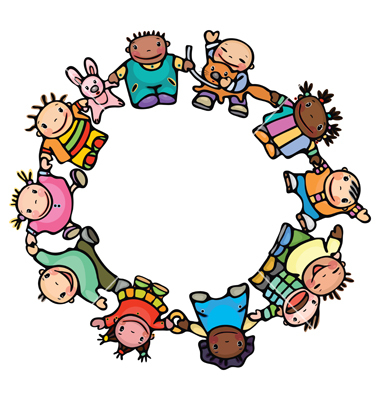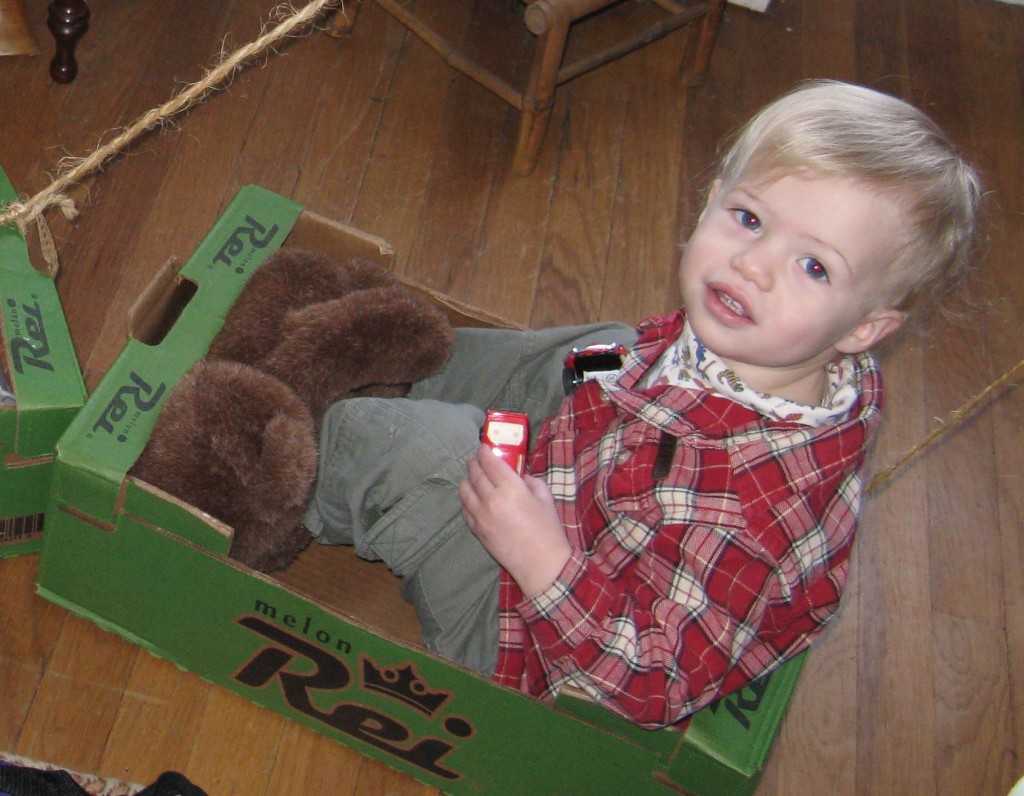A World of Books and Children
Search and enjoy 8 years of posts chock-filled with ideas from It’s OK Not to Share and beyond.
When the film "12 Years a Slave" came out, an adult friend of mine asked: "Should I watch it?"
Yes. It's an uncomfortable topic, and difficult to watch in places, but the history it covers deserves attention. Adults must participate in the world and not be sheltered. But what about the kids? What do we tell them about real-life horrors and "bad guys?"
I'm not alarmed by stranger danger, but I do believe children have a right to know that bad things do happen in the world. Human rights depend on it.
Enormous topics like slavery, the Holocaust, other genocide and human trafficking need to be talked about, and the talks need to start in the family. Kids deserve to come to terms with these parts of humanity gradually, at their own pace. But children - and human rights - are both given a disservice when we keep kids overly sheltered from knowledge about "bad guys" of the world.
Start with the Family Big topics need to start in the family. It's not fair to shelter kids for years and then have them learn about these horrors all at once in, say, 7th grade history class. Families offer emotional support, and families know individual kids' personalities best.
Make it Gradual It's not one big "Talk." Like honest and age appropriate talks about sex ed and human mortality, these discussions are on-going and organic. Little bits here. Little bits there. Start very small and add layers of information as the child grows.
Preschool is OK No, I don't suggest flooding your young child with distressing, advanced topics. Most Holocaust experts advise waiting until at least 8 or 9 - that anything before that age will only bring nightmares. Yet young kids who watch the "Sound of Music" can understand that the Nazis are bad guys. Young kids who learn about Moses in church or synagogue can learn what slavery is, and that people want to escape and be free. These are the simple foundations.
Focus on the helpers This is the same message as helping kids cope with disasters in the news. Look for stories about good people who helped in terrible situations. Kids ought to know that there are more good people than bad people in the world, and that, yes, they can be one of them.
Bring it up to date Kids deserve to know that terrible things are not just confined to history. Slavery is not over, as National Geographic pointed out to millions of readers. Today there are 21 million people enslaved around the world, more than at any time in history. Frame it as an opportunity - we can do something about it.
Take action together Kids' natural outrage at unfairness needs an outlet. Take action, and let your kids participate as you can. Send money to a human rights nonprofit. Start an anti-slavery group, part of Anti-Slavery International. Stand up for an injustice close to home. Support a group that is starting a new Underground Railway. Show your children there may be bad things in the world, but good people are trying to make it better.
Tackling difficult topics is part of parenting. Explain simple facts. Provide emotional support. Teach skills - including conflict mediation. Model positive actions. These are the whole world's problems, and only the whole world can fix them.
When did you first learn about some of the atrocities of history or current events? What helped you understand? How can we best teach our kids and not overwhelm them?
Ideas welcome - this topic is one of many new ones that will be covered in the upcoming sequel to It's OK Not to Share.
Kids spend much of their young lives herded into groups. Now we'll sing, now we'll march in a circle, now everybody clap your hands. Many group activities are terrific fun for young children. Kids often gravitate toward the group and love to sing together, play with a parachute or hear a group story. But there are always times when a child doesn't feel like participating. What to do about that?
A dance teacher recently asked me how to handle kids who didn't want to follow the group activity during the 45-minute class. It was especially frustrating for her since the kids all genuinely liked dance and wanted to be there. No one was forcing them to take the class.
Kids have the right not to participate in a group. Don't force kids to join in. Here are some ideas why:
Don't feel like it. Some days kids like being part of a group, and some days they don't. Sometimes they feel ready to try new things, and other days life seems overwhelming. It's OK for moods and interest to change day by day.
They're scared or worried. Kids back away when they feel uncomfortable about something. Maybe the activity scares them (the whoosh of the parachute, a loud noise), maybe they're worried about another child in the group and what she might do, maybe the group leader's voice or style worries them. Feelings need to be respected. Try asking "Is there something you're worried about?" or "Is there something you don't like?"
Observers deserve respect. Some children are observers. Especially in group settings, they may not be ready to participate, but are actively learning by soaking up the group action around them. Many times a child who never opens his mouth to sing at school will come home and sing all the songs at home for his parents. This type of learning can't be hurried. Kids will observe until they are ready to try more (often longer than an adult judges is 'long enough').
Kids are individuals. Some kids (and adults) don't like groups. Some kids can't take it. Groups can also be developmentally overwhelming or overstimulating for a variety of reasons. Remember, a group is made of a collection of individuals with varying needs.
Don't force kids to participate, but don't let their actions disrupt the group.
So what to do when it's group time? Find a space where they can be. Don't worry if they sit when everyone else stands. Set limits to protect both the individual and the group. "If you want to stand, stand in the back of the room so other kids can see the pictures." "You don't have to dance, but that's what we're doing now. Move to the window so you don't get bumped."
It's hard for us to watch a child who doesn't do what the group does. As an adult, it can feel disruptive or disrespectful. It can also pain us, seeing a child who doesn't fit in or isn't choosing to fit in. But it's worse to force conformity. What sort of lesson is that? Children need to learn to trust their feelings and fears. When it comes to groups, we don't want kids to learn that it's more important to conform and be like the rest even if they feel uncomfortable. Peer pressure only grows stronger as the years go on.
What's your experience balancing group needs with non-participation? Have you ever seen the wonders of observation?
 Find more in It's OK Not To Share...And Other Renegade Rules for Raising Competent and Compassionate Kids, a "Best Parenting Book of 2012" by Parents magazine's Parents.com. Or visit heathershumaker.com to learn more.
Find more in It's OK Not To Share...And Other Renegade Rules for Raising Competent and Compassionate Kids, a "Best Parenting Book of 2012" by Parents magazine's Parents.com. Or visit heathershumaker.com to learn more.
When I was on maternity leave and searching for good daycare, I had definite ideas about what I wanted to see before trusting my child to a stranger. My original criteria included being home-based, play-based, having no TV and good grammar. I wanted someone who would say "lie down" not "lay down" to my child when it came to nap time.
The "no TV" was hardest to find, and I quickly learned to modify my expectations about what was important when it came to grammar.
What to look for in good daycare? I've written about how to find a good play-based preschool, but many parents need full-time care to keep their jobs. At a reader request, here are a few guidelines to help with the search.
Plays with Cardboard Boxes In other words, play-based. Most people will say the daycare is play-based, but I find that the more cardboard boxes are welcomed into the day, the more true play is going on. Other good signs to look for: dress-up clothes and going outside a lot.
Eats Cauliflower Originally, nutritious food didn't make my criteria list. I simply packed food from home to counteract too much grease and sugar. But the young years are a prime time for developing eating habits, and kids learn from modeling. Daycares that expose kids to a wide range of vegetables are a terrific foundation and may introduce your child to foods you typically don't buy.
No TV or 1/2 Hour or Less Daycare is for the youngest children and the American Academy of Pediatricians says no TV for children 0-2. Make sure TVs are off in the house, not just where the children are, but in other rooms. This "no TV" rule also shows you how involved the caregiver is in being engaged with the children.
Advocates for Sleep Besides play and food, sleep is an enormously important part of the day for young kids. Find out about morning naps as well as afternoon naps, ask what they do when a child tries to sleep and can't. Ask how long they get to sleep. The more sleep the better. Daycare is also a great way for children to learn to be flexible about sleep. Kids learn to be able to sleep in new locations.
Sets Limits without Shame Observe and listen how the adults talk to children. Do they compare kids' behavior "I like how Sarah is picking up" or say "Big boys don't cry?" Ideally, you want someone who is comfortable accepting emotions, but sets firm limits on behavior. These are the beginnings of learning conflict management.
Reads Books, Goes on Outings All the good stuff. Make sure there's lots of time for reading aloud, even to the youngest children. Outings are good for kids and are often a sign you've got a confident person in charge. Outings don't have to be elaborate, they can simply be walks in the neighborhood. Other daycare providers visit library story hours, have community gardens, ride city buses, and visit the fire station or post office.
Doesn't Advertise Go by word of mouth to find the gems. The best care providers often don't need to advertise. They're always full.
The Basics Someone you trust. Someone you can afford. Someone who is available. Don't worry if you can't find the ideal daycare right away. Stick with the basics.
Searching for daycare is an anxious time, but remember, the children will be fine. Find an opening, then get on a waiting list for a place that meets more of your criteria later.
What are your criteria? What do you look for? What's the sign of a fantastic daycare provider?



